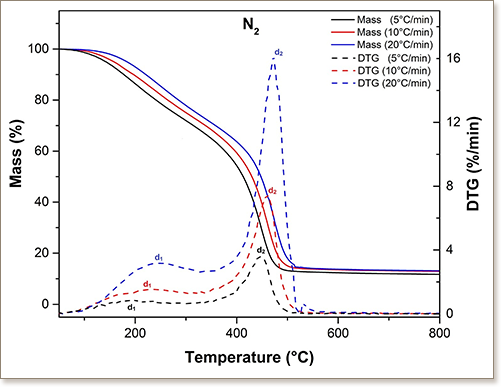Heavy fuel oil pyrolysis and combustion: Kinetics and evolved gases investigated by TGA-FTIR


Heavy fuel oil (HFO) obtained from crude oil distillation is a widely used fuel in marine engines and power generation technologies. In the present study, the pyrolysis and combustion of a Saudi Arabian HFO in nitrogen and in air, respectively, were investigated using non-isothermal thermo-gravimetric analysis (TGA) coupled with a Fourier-transform infrared (FTIR) spectrometer. TG and DTG (differential thermo-gravimetry) were used for the kinetic analysis and to study the mass loss characteristics due to the thermal degradation of HFO at temperatures up to 1000 °C and at various heating rates of 5, 10 and 20 °C/min, in air and N2 atmospheres. FTIR analysis was then performed to study the composition of the evolved gases. The TG/DTG curves during HFO combustion show the presence of three distinct stages: the low temperature oxidation (LTO); fuel decomposition (FD); and high temperature oxidation (HTO) stages. The TG/DTG curves obtained during HFO pyrolysis show the presence of two devolatilization stages similar to that seen in the LTO stage of HFO combustion. Apart from this, the TG/DTG curves obtained during HFO combustion and pyrolysis differ significantly. Kinetic analysis was also performed using the distributed activation energy model, and the kinetic parameter (E) was determined for the different stages of HFO combustion and pyrolysis processes, yielding a good agreement with the measured TG profiles. FTIR analysis showed the signal of CO2 as approximately 50 times more compared to the other pollutant gases under combustion conditions. Under pyrolytic conditions, the signal intensity of alkane functional groups was the highest followed by alkenes. The TGA-FTIR results provide new insights into the overall HFO combustion processes, which can be used to improve combustor designs and control emissions.
DOI: 10.1016/j.jaap.2017.08.008-6501/aa912b

"KAUST shall be a beacon for peace, hope and reconciliation, and shall serve the people of the Kingdom and the world."
King Abdullah bin Abdulaziz Al Saud, 1924 – 2015
Thuwal 23955-6900, Kingdom of Saudi Arabia
© King Abdullah University of Science and Technology. All rights reserved